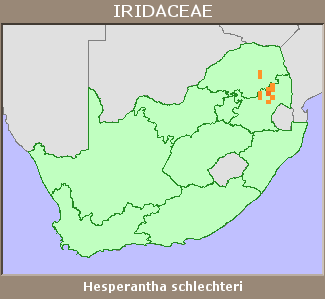|
Scientific Name | Hesperantha schlechteri (Baker) R.C.Foster |
Higher Classification | Monocotyledons |
Family | IRIDACEAE |
Synonyms | Geissorhiza schlechteri Baker, Hesperantha similis N.E.Br. ex R.C.Foster |
National Status |
Status and Criteria | Least Concern |
Assessment Date | 2021/06/23 |
Assessor(s) | W. Foden, L. Potter & T. Patel |
Justification | This species has an extent of occurrence (EOO) of 10 650 km², and an area of occupancy (AOO) of 48 km². It is known from 11subpopulations. It has a stable population trend and has no known threats. It is therefore listed as Least Concern. |
Distribution |
Endemism | South African endemic |
Provincial distribution | Limpopo, Mpumalanga |
Range | This species is endemic to South Africa, and is found in Limpopo and Mpumalanga. It occurs along the escarpment from Woodbush in the north to Long Tom Pass in the south. |
Habitat and Ecology |
Major system | Terrestrial |
Major habitats | Grassland, Savanna |
Description | It occurs on rocks and thin soil on sandstone or quartzite pavement. |
Threats |
| This species has no known threats. |
Population |
It is known from 11 subpopulations and the population trend is stable.
|
Population trend | Stable |
Assessment History |
Taxon assessed |
Status and Criteria |
Citation/Red List version | | Hesperantha schlechteri (Baker) R.C.Foster | Least Concern | Raimondo et al. (2009) | |
Bibliography |
Goldblatt, P. and Manning, J.C. 2020. Iridaceae of southern Africa. Strelitzia 42. South African National Biodiversity Institute, Pretoria.
Raimondo, D., von Staden, L., Foden, W., Victor, J.E., Helme, N.A., Turner, R.C., Kamundi, D.A. and Manyama, P.A. 2009. Red List of South African Plants. Strelitzia 25. South African National Biodiversity Institute, Pretoria.
|
Citation |
| Foden, W., Potter, L. & Patel, T. 2021. Hesperantha schlechteri (Baker) R.C.Foster. National Assessment: Red List of South African Plants version 2024.1. Accessed on 2025/10/26 |
 Comment on this assessment
Comment on this assessment


